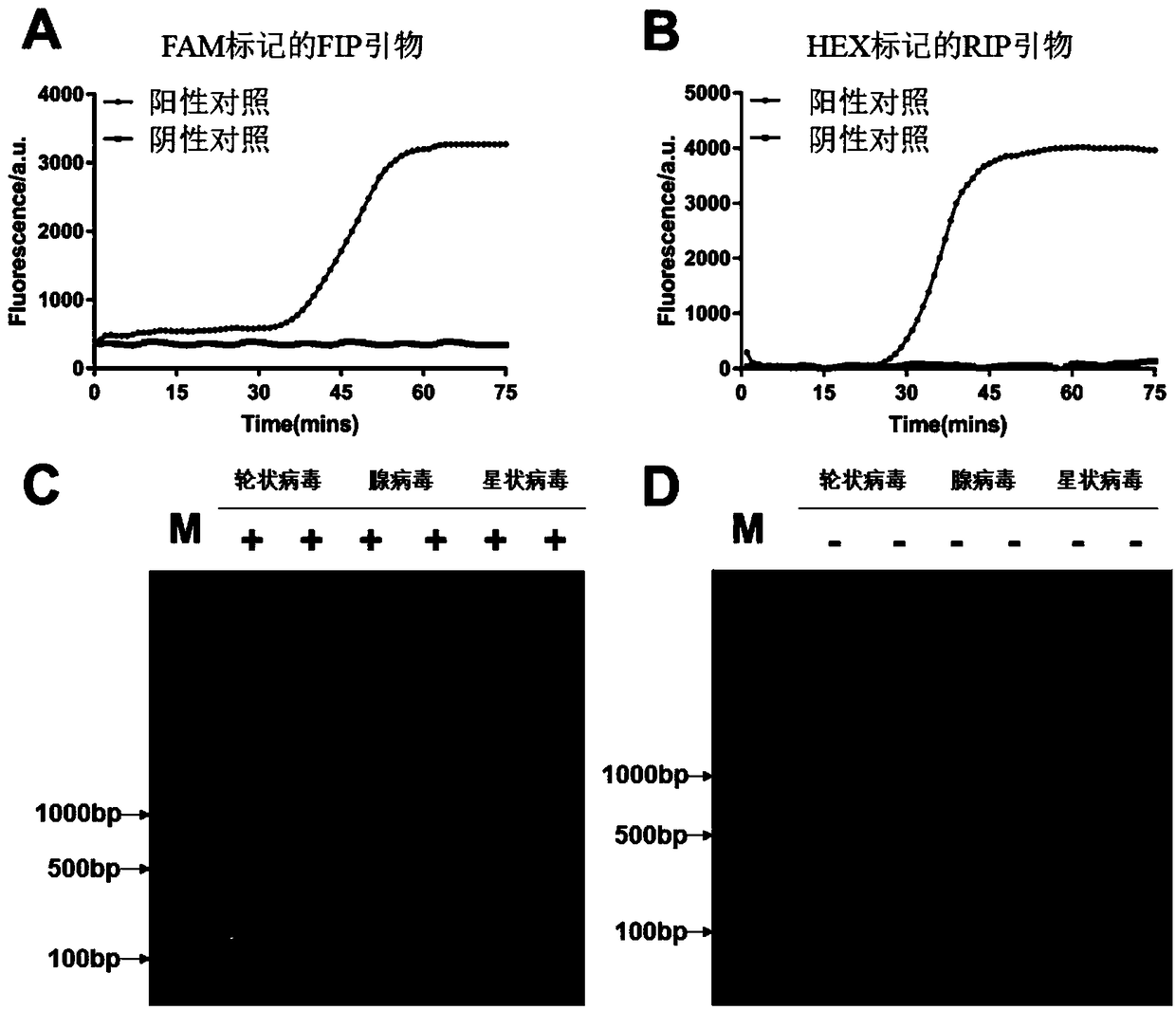Isothermal nucleic acid amplification system with high specificity as well as application thereof
An isothermal nucleic acid amplification and high-specificity technology, applied in the field of warm nucleic acid amplification system and kits of warm nucleic acid amplification system, can solve the problems of limiting clinical practical application, lack of annealing temperature, false positives, etc., and achieve accurate expansion Rapid detection, broad clinical significance, and high specificity
- Summary
- Abstract
- Description
- Claims
- Application Information
AI Technical Summary
Problems solved by technology
Method used
Image
Examples
Embodiment 1
[0032] Embodiment 1—Verification of the basic principle of the Exo-NAT method
[0033] In order to verify the reliability of the mechanism of the Exo-NAT method in this example, the following experiment was adopted: first, the 5' end of the internal primer (FIP / RIP) was labeled with fluorescent groups FAM and HEX, and the 11th base T and The quencher group TAMRA is marked on the 12th base T of RIP to form FAM-FIP and HEX-RIP. When the exonuclease activity works in the reaction, the two fluorescent groups will be cleaved and combined with the quencher group separation, and thus fluorescence growth, as figure 2 The results of parts A and B in the middle test the above hypothesis and prove the reliability of the reaction mechanism; in addition, the method of agarose gel electrophoresis was used to analyze the distribution of the amplified product, and the results were as follows: figure 2 As shown in parts C and D of the three viruses, two bands appeared in the positive sample...
Embodiment 2
[0034] Example 2—Applying the Exo-NAT method to the detection of pathogens in children with diarrhea
[0035]In this example, the Exo-NAT method was used to detect rotavirus, astrovirus and adenovirus, and the embedded fluorescent dye (SYTO-9) combined with melting curve analysis was used to successfully realize the specific detection of the above three viruses.
[0036] In the embodiment, the reaction amplification system is 25 μL, and the concentration of each component is: 20mM Tris-HCl (pH8.8@25℃), 10mM KCl, 10mM (NH 4 ) 2 SO 4 , 8mM MgSO 4 , 0.1% Tween-20, 0.2μΜ FOP / BOP, 1.6μΜ FIP / RIP, 5U full-length Bst DNA polymerase, dNTPs (each 1.4mM), 1×SYTO-9, the reaction conditions are: 65°C, 90mins; where, The primers used to detect group A rotavirus are FOP, ROP, FIP, RIP primers shown in SEQ ID NO.1~SEQ ID NO.4; the primers used to detect astrovirus are as shown in SEQ ID NO.5 ~FOP, ROP, FIP, RIP primers shown in SEQ ID NO.8; primers for detecting adenoviruses are FOP, ROP,...
Embodiment 3
[0038] Example 3—Applying the Exo-NAT method to the multiple detection of pathogens in children with diarrhea
[0039] In this embodiment, the primer sets of the three viruses described in Example 2 are mixed in one system, which can realize multiple detection with high specificity for each virus, and the results are as follows Figure 5 shown, can pass T m The different values can accurately determine the type of pathogens infected. In addition, there are two clinical specimens with double infection of rotavirus and adenovirus, and two characteristic T m The peak value shows that the Exo-NAT method described in this application has the ability of multiple detection. The minimum detection limit of the method was further evaluated for multiple detection, and the results showed that the minimum detection limit was still 100copies / reaction (such as Figure 6 ), which proved that the method has good multiple detection ability.
[0040] The amplification system and Exo-NAT met...
PUM
 Login to View More
Login to View More Abstract
Description
Claims
Application Information
 Login to View More
Login to View More - R&D
- Intellectual Property
- Life Sciences
- Materials
- Tech Scout
- Unparalleled Data Quality
- Higher Quality Content
- 60% Fewer Hallucinations
Browse by: Latest US Patents, China's latest patents, Technical Efficacy Thesaurus, Application Domain, Technology Topic, Popular Technical Reports.
© 2025 PatSnap. All rights reserved.Legal|Privacy policy|Modern Slavery Act Transparency Statement|Sitemap|About US| Contact US: help@patsnap.com



